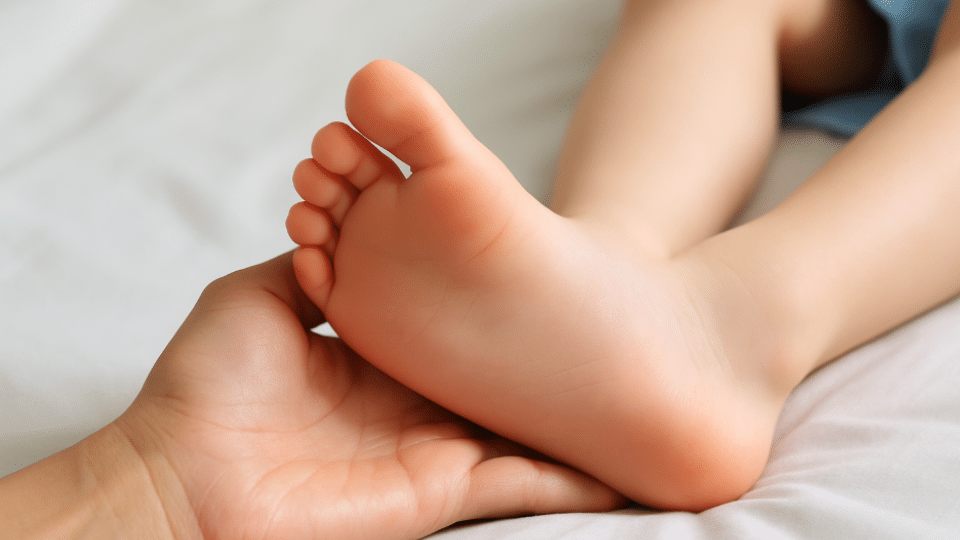Foot pain is often linked to growth but it can also be indicative of underlying issues that need attention. You may be wondering what could be causing it and how you can help. Whether the pain is located at the top of the foot or bottom of the foot, understanding the root causes and taking the right steps for treatment is crucial for your child’s comfort and well-being.
In this article, we’ll explore the common causes of foot pain in children, including pain at the top of the foot and the bottom of the foot, and provide expert solutions for alleviating their discomfort.
Common Causes of Child Foot Pain at Night
Foot pain in children can be caused by a variety of factors. Whether the pain is intermittent or persistent, it’s important to understand its potential causes, especially if it occurs frequently, such as at night. Nighttime pain can disrupt your child’s sleep and quality of life, so knowing what might be causing the pain can help you address it effectively.
1. Growing Pains
This is one of the most common causes of child foot pain at night. As children’s bones and muscles grow, they can experience discomfort in their feet, particularly in the lower extremities. These pains often occur in the evening or at night and are typically temporary. Growing pains are usually more prevalent in children ages 3–12, especially during periods of rapid growth.
Symptoms:
- Pain in the legs or feet, often at night.
- Discomfort that subsides with gentle stretching or massage.
Solution: Stretching the feet and legs before bedtime, providing gentle massages, and using warm compresses can help relieve growing pains.
2. Plantar Fasciitis
This is a condition that causes pain at the bottom of the foot, specifically in the heel or arch. This condition occurs when the plantar fascia (the band of tissue connecting the heel to the toes) becomes inflamed. While it’s more common in adults, it can affect children, especially those who are physically active or overweight.
Symptoms:
- Pain at the bottom of the foot, particularly in the heel.
- Discomfort that worsens after periods of rest, such as in the morning or after a nap.
Solution: Foot stretches, proper footwear with arch support, and possibly custom orthotics can help manage the symptoms of plantar fasciitis in children. However, if the pain persists or interferes with daily activities, it’s important to consult a podiatrist for a proper diagnosis and treatment plan. For more information on selecting the best shoes for your child’s foot health, check out our Shoes, Shoes, Shoes guide.
3. Flat Feet (Pes Planus)
Children with flat feet, or pes planus, may experience pain in the bottom of the foot due to a lack of an arch. While some children have flat feet and do not experience pain, others may develop discomfort as the foot structure doesn’t provide the necessary support. This can lead to stress on the muscles and ligaments in the feet, resulting in pain.
Symptoms:
- Pain in the arch or bottom of the foot, especially after physical activity.
- Tired or aching feet after walking or standing for long periods.
Solution: Supportive footwear and custom orthotics can help provide the necessary arch support for children with flat feet, alleviating discomfort and improving posture. For more information on how custom orthotics can improve foot comfort and mobility, check out our Custom Orthotics: The Key to Foot Comfort and Mobility guide.
4. Injury or Overuse
Children who are active in sports or physical activities may experience foot pain due to overuse or injury. This can lead to pain at the top of the foot or the bottom of the foot, depending on the type of activity. Top of foot pain in child can result from injuries like extensor tendinitis, where the tendons that help lift the toes become inflamed due to overuse.
Symptoms:
- Swelling or tenderness on the top or bottom of the foot.
- Pain that increases with activity or movement.
Solution: Rest, ice, and elevation can help reduce inflammation. If the pain persists, a visit to the podiatrist is essential for diagnosing the injury and providing appropriate treatment.
5. Sever’s Disease (Calcaneal Apophysitis)
Sever’s disease is an inflammation of the growth plate in the heel and is commonly seen in children between the ages of 8 and 14. This condition is often triggered by physical activity, particularly running or jumping, which can cause pain at the bottom of the foot (heel area).
Symptoms:
- Heel pain that worsens with activity.
- Pain in the bottom of the foot, especially when walking or running.
Solution: Rest, ice, and stretching exercises for the Achilles tendon can help relieve the pain associated with Sever’s disease. Proper footwear and possibly heel cups can also be beneficial.
For more information on foot pain and expert tips for relief, check out our Foot Pain Explained blog.

Solutions and Relief for Child Foot Pain at Night
While many cases of child foot pain at night resolve on their own, there are steps parents can take to help alleviate their child’s discomfort:
1. Supportive Footwear
One of the best ways to address top of foot pain in child or bottom of foot pain is by ensuring your child wears shoes that provide proper support. Avoid shoes with high heels or stiff soles. Look for shoes that offer adequate arch support and cushioning.
2. Foot Stretches
Simple foot stretches can help improve flexibility and alleviate tension. Gently stretching the foot and calf muscles before bed can help relax the feet and reduce discomfort. This is particularly helpful for conditions like growing pains and plantar fasciitis.
3. Rest and Ice
For pain caused by overuse or injury, rest and ice can help reduce swelling and alleviate discomfort. If your child complains of foot pain from running or other activities, make sure they take breaks and apply ice to the affected area for 15-20 minutes.
4. Massage
Massaging the feet can help relieve tension and improve circulation, providing temporary relief for foot pain. Gently rub the soles and the tops of your child’s feet, paying special attention to any tender spots.
When to Seek Professional Help
If your child’s foot pain at night is persistent, worsening, or interfering with their ability to walk or play, it’s important to seek professional care. A podiatrist can assess the underlying cause of the pain and provide a tailored treatment plan. This may include custom orthotics, physical therapy, or other interventions depending on the diagnosis. If you’re unsure about whether your child’s foot pain requires expert care, learn more about what a foot doctor is and when should you see one.
Conclusion: Keep Your Child’s Feet Healthy and Pain-Free
Child foot pain at night can be a source of concern for both children and parents, but with the right care, it can often be managed effectively. By understanding the common causes of foot pain and seeking early treatment, you can help your child stay active and comfortable throughout their daily activities. Always consult with a podiatrist if the pain persists or worsens to ensure the best outcome for your child’s foot health.
At Fall Creek Foot & Ankle, we specialize in diagnosing and treating foot conditions in children. If your child is experiencing foot pain, don’t hesitate to schedule an appointment with our experienced podiatrists for a thorough evaluation.
